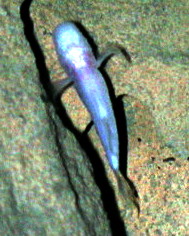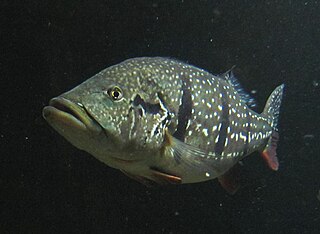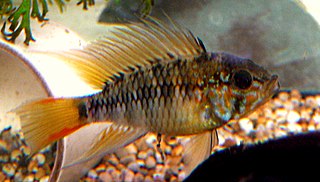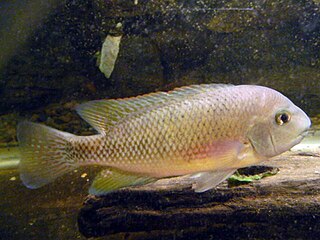The northern cavefish or northern blindfish is found in caves through Kentucky and southern Indiana. The International Union for Conservation of Nature lists the species as near threatened.

The Amblyopsidae are a fish family commonly referred to as cavefish, blindfish, or swampfish. They are small freshwater fish found in the dark environments of caves, springs and swamps in the eastern half of the United States. Like other troglobites, most amblyopsids exhibit adaptations to these dark environments, including the lack of functional eyes and the absence of pigmentation. More than 200 species of cavefishes are known, but only six of these are in the family Amblyopsidae. One of these, Forbesichthys agassizii, spends time both underground and aboveground. A seventh species in this family, Chologaster cornuta, is not a cave-dweller but lives in aboveground swamps.

Cichlasoma is a genus of freshwater fish in the cichlid family. The genus was previously very large, including cichlids from North America, including Central America, and South America.
Paraneetroplus is a genus of cichlid fish native to moderately to fast-flowing waters in the Coatzacoalcos, Grijalva and Papaloapan river basins in southern Mexico. They reach up to 20–25.5 cm (8–10 in) in length.

Archocentrus is a genus of cichlid fish from Central America. It currently contains a single species, the flier cichlid, which is found in stagnant and slow-moving freshwater habitats such as lakes, ponds, ditches, swamps and rivers in Honduras, Nicaragua and Costa Rica. It is up to 11 cm (4.3 in) long and feeds on invertebrates and detritus.

Typhlichthys subterraneus, the southern cavefish, is a species of cavefish in the family Amblyopsidae endemic to karst regions of the eastern United States.

The Salvin's cichlid, also known as the yellow-belly cichlid or tricolored cichlid, is a species of the family Cichlidae. It is found in rivers of the Atlantic slope of southern Mexico, Belize, and Guatemala.

The Cichlasomatinae are a subfamily of cichlid fishes, including all cichlids native to the Greater Antilles, United States, Mexico and Central America, and many of the cichlids from South America. The subfamily Cichlasomatinae is often divided into two tribes: Cichlasomatini and Heroini, however some authorities classify these two tribes as part of the wider Neotropical and marginally Nearctic subfamily Cichlinae.

Cavefish or cave fish is a generic term for fresh and brackish water fish adapted to life in caves and other underground habitats. Related terms are subterranean fish, troglomorphic fish, troglobitic fish, stygobitic fish, phreatic fish, and hypogean fish.

Retroculus is a genus of cichlids native to tropical South America, where three are native to rivers in southeastern Amazon Basin in Brazil, while the final is native to rivers in Amapá (Brazil) and French Guiana. It is the sole genus included in the subfamily Retroculinae, although some authorities classify this as a tribe, Retroculini, of the subfamily Cichlinae. These rheophilic cichlids are superficially similar to Geophagus.

The Cichlinae are a subfamily of fishes in the cichlid family, native to Central and South America.

The Astronotinae are a subfamily of cichlids from South America, where they are found in the Amazon, Orinoco, Paraná, and Paraguay River basins, and various rivers in the Guianas. The subfamily includes three genera, each with two species. Although in other classifications all three genera are placed in the subfamily Cichlinae with Astronotus being the only genus in the monogeneric tribe Astronotini of the subfamily Cichlinae and the other two genera being placed in the tribe Cichlini.

Heroini is a fish tribe from the Cichlasomatinae subfamily in the cichlid family. All cichlids native to the Greater Antilles, United States, Mexico and northern Central America are members of this tribe. It also includes most cichlid species in southern Central America and several species from South America. A large percentage of its species were formerly placed in the genus Cichlasoma but have since been moved to other genera.

Apistogramma macmasteri is a dwarf cichlid in the tribe Geophagini, one of the tribes of the subfamily of American cichlids, the Cichlinae. It is a freshwater fish that lives in the rivers Guaytiquía and Metica in the Meta River system. The Meta river system is a part of the Orinoco basin in Colombia. They live in areas with soft sandy bottom and plenty of dead roots and branches in the water. Plants are uncommon in areas where Apistogramma macmasteri is found.

Apistogramma viejita is a dwarf cichlid in the subfamily Cichlinae, in the tribe Geophagini. It is a benthopelagic freshwater fish that lives in the Meta River and the Orinoco River in Colombia. They grow up to 4.6 cm in standard length.

Amblyopsis is a genus of small fish in the family Amblyopsidae that are endemic to the central and eastern United States. Like other cavefish, they lack pigmentation and are blind. The most recently described species was in 2014. Uniquely among fish, Amblyopsis brood their eggs in the gill chambers. It was formerly incorrectly speculated that the same brooding behavior existed in other genera in the family and in the pirate perch. During the Pleistocene period, the modern Ohio river was a barrier of dispersal and created a great genetic variation, leading to two phylogenetically distinct lineages from the species Amblyopsis.
Kihnichthys ufermanni, the Usumacinta cichlid, is a species of cichlid found in a few rivers in the Usumacinta River basin in Guatemala and southern Mexico. It typically occurs in rivers that are about 10–50 m (33–164 ft) wide, fairly deep, have few or no aquaritc plants, and a variable water current. This species is the only known member of its genus, but several of its features, including the chisel-like teeth, are shared with Cincelichthys and whether they should be merged into a single genus is not yet fully resolved; a review in 2020 recommended that the Usumacinta cichlid should be moved into Cincelichthys. The Usumacinta cichlid reaches a standard length of 25 cm (10 in).
Rheoheros is a genus of cichlids. These freshwater fish are found in the Atlantic slope of Mexico and Guatemala in moderately to fast-flowing waters of the Grijalva-Usumacinta River system. Depending on species, they reach up to 12–25 cm (4.5–10 in) in length.

Talamancaheros is a genus of cichlid fish found in fast- and moderately-flowing rivers on the Pacific slope of the Talamanca mountains of Costa Rica and western Panama. Talamancaheros reaches up to 25 cm (10 in) in standard length.

Cichlastomatini is a tribe of cichlids from South America, one of two tribes that make up the subfamily Cichlasomatinae. They were recognised in 1983 as an assemblage by the Swedish ichthyologist Sven O. Kullander by their four rather than five 5 dentary foramina in the lateralis canal system of the head, describing them as closely related to the genus Cichlasoma. Melanie Stiassny suggested that these fishes recognised as a clade by Kullander were divided into two groupings in 1991 which she termed cichlasomines and heroines, Kullander formally raised these to the tribes Cichlasomatini and Heroini of the subfamily Cichlasomatinae in 1999. In other classifications the tribe Cichlasomatini is placed in the subfamily Cichlinae.















